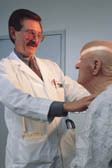 Beyond conventional treatments There is good news and bad news on the cancer front. The good news is that the rate of new cases of cancer and deaths from cancer decreased three percent in the United States and Canada for the first time since record-keeping began in the 1930s. Death rates for some fearsome cancers, including breast and prostate cancer, have decreased, while specific cancers such as childhood leukemia and testicular cancer have become largely treatable - and curable - diseases. Treatments for even the most aggressive cancers have increased length of survival and improved quality of life for millions of people with cancer. The bad news? It just isn't enough. "In the majority of patients, cancer is already in an advanced stage when it is first discovered," says David Gandara, director of clinical research for the UC Davis Cancer Center and one of the program's leading lung cancer researchers. "With these patients, the goal of therapy is to prolong survival while maintaining quality of life. But we would like to do so much more. We would like to transform treatment into long-term control, or even cure."
Home |
Table of Contents |
To our Readers |
Building on Basics UC Davis Health System | © 2000, 2001, 2002 UC Regents. All rights reserved. |
UC Davis researchers are part of a worldwide community of scientists developing new approaches to cancer. |

